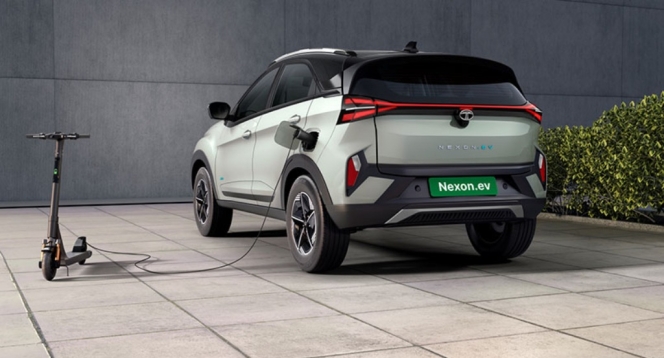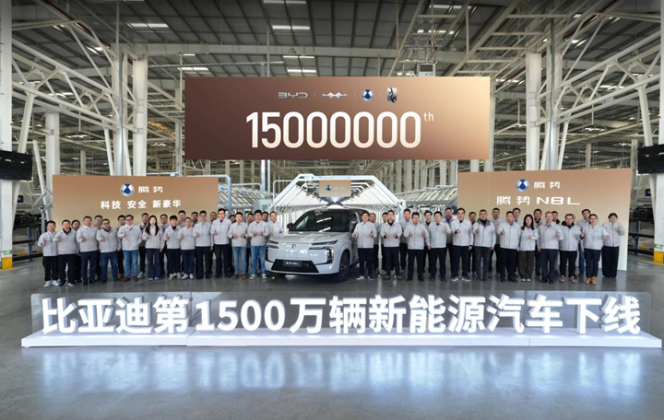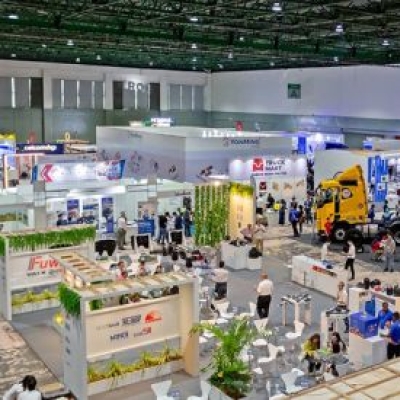Cummins Group in India Unveils Fuel Agnostic Platform At Auto Expo 2023
- By MT News
- January 11, 2023

Cummins Group in India, a power solutions technology provider, unveiled a fuel agnostic platform and its diversified range of hydrogen technologies power solutions at Auto Expo 2023 today, in India Expo Mart, Noida, India.
At the product launch event, the company brought its Destination Zero strategy to life by unveiling low zero emission products focused on decarbonisation. According to Cummins, the launch event was presided by senior officials from Cummins Inc and India where the leadership team reinforced that Cummins is actively working to transition its customers to products that ultimately eliminate carbon emission and will have the right products to serve customers throughout the transition.
Speaking at the launch event, Ashwath Ram, Managing Director, Cummins Group in India, said, “We share India’s vision of ‘Energy for Sustainable Growth’ and achieving net zero carbon emissions by 2070. With a promising combination of our strong, global technological expertise and our deep understanding of the India market due to our 60+ year legacy, we are well positioned to contribute toward India’s aim of becoming a cleaner and greener ‘Atmanirbhar Bharat’. We understand that the road transport sector has a major role to play in helping reduce emissions so India can meet its climate goals, and we are deeply committed to play our part in powering the nation’s decarbonisation journey. Our innovation can be seen in action through the range of solutions on display at Auto Expo this week, and it reaffirms our commitment to decarbonisation. We will continue to work together with our stakeholders on low carbon and zero emissions solutions that further our shared goal of reducing our carbon footprint on the planet.”
Srikanth Padmanabhan, President – Engine Business, Cummins Inc, said, “Realising a net-zero future will require a range of technologies, and no one understands that better than Cummins. Our Destination Zero strategy considers the significant diversity of applications in our industry. We power some of the world's most demanding and economically vital applications. There is not a single solution or path to zero that will work for all these applications, considering the variation in duty cycles and operating environments and locations. We must advance solutions in a way that secures a sustainable future for the industries that keep the world running. That's why we have developed the broadest range of ultra-low and zero-emission technologies dedicated to the commercial vehicle industry, which is being showcased at the Auto Expo.”
Destination Zero is part of the framework of Cummins’ broader PLANET 2050 environmental sustainability strategy, which also includes a focus on improving the communities the company operates in, and using natural resources in the most responsible way.
Cummins is showcasing its fuel agnostic platform, demonstrating a practical way to reduce emissions now, using technology that OEMs, fleet managers and operators are familiar with. Cummins claims that the fuel-agnostic architecture utilises a common base engine with cylinder heads and fuel systems, specifically tailored to fuel ranging from diesel to natural gas to renewable to natural gas to hydrogen. The platform offers OEMs common engine architecture across multiple fuel types, resulting to a high degree of parts commonality.
At the Auto Expo 2023, the fuel-agnostic platform concept is demonstrated through –
Move to zero carbon fuel (Innovation in ICE technology – fuel agnostic platform)
- Hydrogen Internal Combustion Engine (B6.7H engine)
Cummins states that part of the fuel agnostic platform is what could become the most practical to reaching zero carbon emissions for medium- and heavy-duty truck manufacturers – Cummins’ hydrogen internal combustion B6.7H engine. When paired with green hydrogen, this engine produces zero Well-To-Wheel CO2 emissions. Moreover, it has an industry-leading 700 bar hydrogen tank that enables quick refueling, as per Cummins.
With the B6.7H engine, Cummins has addressed the medium- and heavy-duty trucks and buses segment, thus highlighting the technology’s ability to support decarbonisation across multiple duty-cycles.
Immediate shift to low-carbon technology
Natural Gas Internal Combustion Engine (CNG/LNG/Bio-CNG)
Cummins claims that natural gas engines help lower emissions and reduce a vehicle’s overall environmental impact, without sacrificing the performance needed to get the job done. Natural gas engines are also the most mature, proven and least disruptive alternative power technology available today. According to Cummins, natural gas infrastructure is available and accelerates the government’s vision of increasing natural gas share in energy mix from 6-15 percent by 2030. Significant investments are already planned to build the infrastructure, both on CNG and LNG, and this technology will help achieve the government’s vision.
Cummins states that its B6.7H Natural Gas Internal Combustion Engine is the industry’s first big bore natural gas engine, purpose built to support CO2 emissions reduction in long distance trucking, up to 10 percent Co2 reduction achievable for CNG/LNG over a diesel truck and up to 75 percent Co2 reduction achievable when used with bio-gas, thus improving air quality as per BSVI compliance and capability of Euro VII, too.
Switching to the latest generation diesel technology
Advanced diesel (B6.7 diesel/Bio-diesel)
With a foundation of almost 700,000 Euro VI, low emission engines supplied, Cummins showcased its latest generation advanced diesel platform. As per Cummins, its advanced diesel B6.7 engines give customers the opportunity to reduce emissions, alongside significant improvements in power and torque, as they are built on the industry’s first fuel agnostic platform, compliant to BSVI OBDIII emission norms.
Innovative zero emission solutions
Electrolyzer (for green H2 generation)
Electrolyzer takes the water as input and splits it into hydrogen and oxygen as output. Cummins claims that when supplied with renewable energy, the H2 generated is called green H2, since the process doesn’t have any carbon footprint. Cummins has supplied and commissioned more than 600 electrolyzers worldwide with PEM and alkaline technologies, it states. The company displayed a modular variant of the state-of-the-art electrolyzer-stack technology at the Auto Expo 2023.
Hydrogen fuel cell
Cummins’ latest generation fuel cell engine will showcase the rapid evolution of zero emissions technologies. For customers that need and want to reach zero greenhouse gas emissions today, hydrogen fuel cells would be an apt solution when supplied with green H2 as fuel, according to Cummins. Building on the deployments of more than 2,000 fuel cells globally for various applications, including buses, trucks, stationery power and railways, this next generation product provides improved power density, efficiency and durability, and is available in single (rated power - 125kW) and dual module (rated power - 240kW) engines for both medium- and heavy-duty vehicles that can work in diverse working environments from -30 °C to 45 °C, with 60 percent peak efficiency.
Battery-electric technology (Battery-LFP and NMC)
Drawing on deep duty cycle and application experience, Cummins has developed the new generation battery pack solutions. The company is showcasing multiple batteries that help customers to reach zero emissions today, Cummins claims. These lithium-ion batteries are with distinct chemistries, like lithium-iron phosphate (LFP) and nickel manganese cobalt (NMC) that optimise to serve diverse needs of charging time, weight, range and cost economics of a variety of applications in the market. According to Cummins, the batteries are equipped with advanced Battery Management System (BMS) for monitoring various critical battery parameters, diagnostics and improve the battery life and performance.
Electric powertrain technology (14Xe ePowertrain)
Cummins recently announced its acquisition of Meritor, a global supplier of drivetrain, mobility, braking and electric powertrain technologies. The addition of Meritor strengthens Cummins’ industry-leading range of powertrain components and will enable accelerated development of electrified power solutions. As per Cummins, together with Meritor, they will move further and faster in developing economically viable decarbonised powertrain solutions that advance the company’s Destination Zero strategy.
The 14Xe ePowertrain is designed for scalability and can be adapted to fit various electric powertrain needs based on the vehicle application and duty cycle. Cummins claims that its design provides high-efficiency, lower weight and better turning radius. Thus, it enables longer vehicle range by integrating the motor and transmission into the axle, thereby freeing up space for more batteries.
Chartered Speed Deploys Electric Buses For DCM Shriram Staff Transport
- By MT Bureau
- December 24, 2025

Chartered Speed has deployed 11 electric buses for staff transportation for DCM Shriram at Jhagadia GIDC, Bharuch. The service was inaugurated by Sanyam Gandhi, Whole-time Director at Chartered Speed and Aditya Shriram, Deputy Managing Director at DCM Shriram.
The deployment is part of an effort to shift employee mobility towards electrification. Chartered Speed operates a fleet of over 2,000 buses across six states, serving 350,000 passengers daily.
The electric buses are equipped with several technologies for fleet management and passenger safety. It comes with real-time GPS tracking and onboard Driver Monitoring Systems (DMS). CCTV cameras, fire protection systems and first-aid kits are installed in every vehicle.
The company currently provides school and staff transportation services to various clients, including GHCL Limited and Apple Global School.
Sanyam Gandhi, Whole-time Director, Chartered Speed, said, “With the recent deployment of electric buses, we are strengthening our commitment to reducing the carbon footprint of our operations and supporting the transition to greener transportation solutions. Our vision is of building a large, clean energy-powered fleet that aligns with global trends towards electrification in public transport. We remain focused on integrating technology in our services not only enhances operational efficiency but also fosters a culture of safety that we believe is essential for the future of transportation.”
- Tata Motors
- TATA.ev
- Nexon.ev
- Tiago.ev
- Curvv.ev
- Harrier.ev
- XPRES-T EV
- Shailesh Chandra
- Sierra.ev
- Punch.ev
- Avinya
- Agratas
Tata Motors Surpasses 250,000 EV Sales In India
- By MT Bureau
- December 23, 2025

Tata Motors, one of the leading passenger vehicle manufacturers in the country, has attained a new milestone in the Indian electric vehicle (EV) market, with cumulative sales of its TATA.ev range exceeding 250,000 units.
Since the launch of the Nexon.ev in 2020, the company has secured a 66 percent market share of all electric passenger vehicles sold in India to date. The Nexon.ev has become the first electric model in the country to surpass 100,000 cumulative sales.
At present, the company’s green vehicle offering includes the Tiago.ev, Punch.ev, Nexon.ev, Curvv.ev and Harrier.ev for personal use, alongside the XPRES-T EV for fleet operations.
To support its EV customers, Tata Motors has established an ecosystem, which includes access to over 200,000 charging points, including home, community and public chargers. A digital platform providing coverage for over 20,000 public chargers. Around 100 mega charging hubs operational across key corridors, offering speeds of more than 120kW. Approximately 1,500 dedicated EV service bays nationwide, staffed by over 5,000 technicians.
The automaker stated that every TATA.ev vehicle is manufactured with more than 50 percent local content. In collaboration with other Tata Group companies, the firm has localised the production of battery packs and battery management systems. The supply chain also includes domestic production of power electronics, wiring harnesses and thermal management systems.
Going forward, Tata Motors has outlined a robust growth strategy through to 2030:
- Upcoming Launches: The Sierra.ev and a new Punch.ev are scheduled for release in CY26, followed by the Avinya luxury range at the end of 2026.
- Portfolio Growth: Five new nameplates are planned by FY2030.
- Infrastructure Targets: The company aims for 400,000 charge points by CY2027 and 1 million by 2030.
- Battery Sourcing: Future models will use battery cells produced at the Agratas gigafactory in Sanand.
Shailesh Chandra, MD & CEO, Tata Motors Passenger Vehicles, said, “Crossing 250,000 EV sales reflects how electric mobility is fast becoming part of everyday Indian life. Our customers are driving more, travelling farther, and increasingly trusting EVs as their only cars. Our EV journey which began in 2018, was never about leading alone but about building the ecosystem to enable India’s transition to clean mobility. This progress is the outcome of the government’s forward-thinking policies, the steadfast support of our supplier partners and charging infrastructure providers and above all, the trust and enthusiasm of TATA.ev customers. As EV adoption accelerates, our commitment remains clear: to mainstream electric mobility by making it accessible across segments, strengthening the ecosystem, and investing in India-first technology and localization. This is how we will continue to lead India’s growing EV market.”
The company also intends to focus on the circular economy by reusing batteries for energy storage and providing battery health checks for second-hand owners.
Forsee Power To Supply ZEN LFP Battery Systems To Mexico's MegaFlux
- By MT Bureau
- December 22, 2025

French-headquartered battery systems manufacturer Forsee Power has announced that MegaFlux, a Mexico-based powertrain integrator, has selected its ZEN LFP battery system for its heavy vehicle electric powertrains.
MegaFlux develops electric powertrains for trucks and buses, including retrofit solutions that convert diesel vehicles to electric. The company also provides charging infrastructure and energy management services.
The ZEN LFP product line uses lithium-ion LFP chemistry and is designed for buses, trucks and off-highway vehicles. The batteries are available in 36 kWh and 55 kWh formats, allowing for various voltage and energy combinations. The LFP battery has an energy density of 240 Wh/L. Being a modular system, upto to two modules can be stacked to optimise vehicle space. The battery has 6,000 charging lifecycle and is ISO 26262 ASIL-C and industry standards including R100-3 and R10.6 certified.
The use of LFP (Lithium Iron Phosphate) chemistry is intended to provide a lower Total Cost of Ownership (TCO) for operators due to its thermal stability and cycle life, factors that are relevant to the operating conditions in markets such as Mexico.
MegaFlux will integrate the ZEN LFP batteries into powertrains sold to original equipment manufacturers (OEMs) and into its vehicle conversion projects.
BYD Rolls Out 15 Millionth New Energy Vehicle As Global EV Sales Rise
- By MT Bureau
- December 19, 2025

Chinese automotive major BYD has celebrated the production of its 15 millionth new energy vehicle (NEV) at its Jinan Factory. The milestone vehicle is a Denza N8L, which also represents the 15,000th unit of this six-seat SUV model.
The company reported sales of 4.182 million units from January to November 2025, a YoY growth of 11.3 percent. Global markets contributed to this performance, with overseas sales reaching 917,000 units, surpassing the total volume recorded in 2024. BYD now operates in more than 119 countries and regions.
Technological innovation continues to drive the company's operations. In the first three quarters of 2025, R&D expenditure rose to CNY 43.75 billion, a 31 percent increase compared to the previous year. Total cumulative investment in research and development has now exceeded CNY 220 billion.
The Denza brand has entered markets in Singapore, Thailand and Malaysia. During the first half of the year, the Denza D9 became the top-selling luxury MPV in Indonesia, Thailand and Malaysia.
The brand has extended its presence into Europe and Latin America. This expansion is part of a strategy to increase the electrification of the global luxury automotive sector. Denza recently showcased the D9 at the São Paulo International Motor Show to support its growth in the region.






Comments (0)
ADD COMMENT